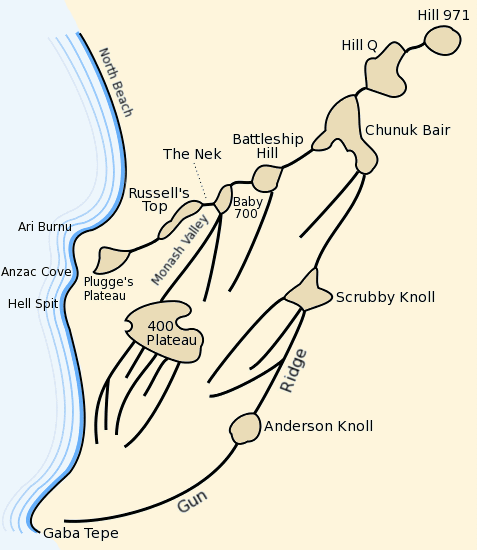|
Battle For Baby 700
The battle for Baby 700 (2/3 May 1915), was an engagement fought during the Gallipoli Campaign of the First World War, between the forces of the British Empire and the Ottoman Turkish Empire. On 25 April 1915, the Australian and New Zealand Army Corps (ANZAC), conducted an amphibious landing on the Gallipoli Peninsula. The landing at Anzac Cove was supposed to capture Baby 700, on the third ridge from the Aegean coast on the first day, but Turkish opposition being stronger than expected foiled their plans and they were forced to form a defensive perimeter on the second ridge. Having successfully defended against a Turkish counter-attack on 27 April, they realised it would strengthen their position if they captured Baby 700. The operation was given to the New Zealand and Australian Division, their then strongest formation, supported by the 1st Royal Naval Brigade. The attack proved a costly failure for the British Empire forces, after the New Zealand troops on the left fla ... [...More Info...] [...Related Items...] OR: [Wikipedia] [Google] [Baidu] |
Battle Of Lone Pine
The Battle of Lone Pine (also known as the Battle of Kanlı Sırt) was fought between Australian and New Zealand Army Corps (ANZAC) and Ottoman Empire forces during the Gallipoli Campaign of the First World War, between 6 and 10 August 1915. The battle was part of a diversionary attack to draw Ottoman attention away from the main assaults being conducted by British, Indian and New Zealand troops around Sari Bair, Chunuk Bair and Hill 971, which became known as the August Offensive. At Lone Pine, the assaulting force, initially consisting of the Australian 1st Brigade, managed to capture the main trench line from the two Ottoman battalions that were defending the position in the first few hours of the fighting on 6 August. Over the next three days, the fighting continued as the Ottomans brought up reinforcements and launched numerous counterattacks in an attempt to recapture the ground they had lost. As the counterattacks intensified the ANZACs brought up two fresh battalions t ... [...More Info...] [...Related Items...] OR: [Wikipedia] [Google] [Baidu] |
1st Australian Division
The 1st Division is headquartered in Enoggera, a suburb of Brisbane. The division was first formed in 1914 for service during World War I as a part of the Australian Imperial Force (AIF). It was initially part of the Australian and New Zealand Army Corps (ANZAC) and served with that formation during the Gallipoli campaign, before later serving on the Western Front. After the war, the division became a part-time unit based in New South Wales, and during World War II it undertook defensive duties in Australia before being disbanded in 1945. After World War II, the division remained off the Australian Army's order of battle until the 1960s, when it was reformed in New South Wales. In 1965 it adopted a certification role, determining the operational readiness of units deploying to Vietnam. It was re-formed in 1973 as a full division based in Queensland and in the decades that followed it formed the Australian Army's main formation, including both Regular and Reserve personnel. Th ... [...More Info...] [...Related Items...] OR: [Wikipedia] [Google] [Baidu] |
Harold Bridgwood Walker
Lieutenant-General Sir Harold Bridgwood Walker, (26 April 1862 – 5 November 1934) was a senior British Army commander who led Australian and New Zealand forces for much of the First World War. He was highly regarded by the men he commanded and was only replaced in 1918 when politics dictated that all divisions of the Australian Imperial Force should be commanded by Australians. Early life Walker was born on 26 April 1862 in Dilhorne, North Staffordshire, England. His father was James Harold Walker, an Anglican clergyman, and his mother was Mary Walker (''née'' Bridgwood). He was a descendant of George Walker. He was educated at Shrewsbury School and Jesus College, Cambridge. However, he did not graduate, having left before completing his degree. Military career Walker was commissioned into the British Army as a lieutenant in the Duke of Cornwall's Light Infantry on 14 May 1884 and served on the Nile Expedition in 1884 and 1885. He was promoted to captain on 16 December 1891 ... [...More Info...] [...Related Items...] OR: [Wikipedia] [Google] [Baidu] |
Brigadier-General
Brigadier general or Brigade general is a military rank used in many countries. It is the lowest ranking general officer in some countries. The rank is usually above a colonel, and below a major general or divisional general. When appointed to a field command, a brigadier general is typically in command of a brigade consisting of around 4,000 troops (four battalions). Variants Brigadier general Brigadier general (Brig. Gen.) is a military rank used in many countries. It is the lowest ranking general officer in some countries, usually sitting between the ranks of colonel and major general. When appointed to a field command, a brigadier general is typically in command of a brigade consisting of around 4,000 troops (four battalions). In some countries, this rank is given the name of ''brigadier'', which is usually equivalent to ''brigadier general'' in the armies of nations that use the rank. The rank can be traced back to the militaries of Europe where a "brigadier general ... [...More Info...] [...Related Items...] OR: [Wikipedia] [Google] [Baidu] |
1st Australian Brigade
1st Brigade is a combined arms formation of the Australian Army. Formed in 1903 as a militia formation based in New South Wales, it was reconstituted as part of the Australian Imperial Force in 1914 for service during World War I, the brigade fought at Gallipoli and on the Western Front before being disbanded in mid-1919. In 1921, the 1st Brigade was re-raised as a unit of Australia's part-time military forces, based in New South Wales. During World War II the brigade undertook defensive duties before being disbanded. In 1948, it was re-raised as an integral part of the Australian Regular Army. Currently the brigade is based at Robertson Barracks in Darwin and at RAAF Base Edinburgh near Adelaide, South Australia. It is the first of the Australian Army brigades to be re-organised as a combat brigade under Plan Beersheba. History Formation Originally formed in 1903 as a Militia unit of the Commonwealth Military Forces, it was established in New South Wales and consisted of ... [...More Info...] [...Related Items...] OR: [Wikipedia] [Google] [Baidu] |
1st New Zealand Brigade
The 1st Brigade is currently the largest unit of the New Zealand Army, and contains most of the army's deployable units. The brigade was formed on 13 December 2011 by amalgamating the 2nd Land Force Group and 3rd Land Force Group. Its establishment formed part of the 'Army 2015' package of reforms. Previous 1st Brigades in the New Zealand Army have included a brigade in the Middle East and France, 1916–19, a home defence formation active during the Second World War (part of the North Island home defence 1st Division), and a 1 Brigade / Integrated Expansion Force formed to direct three Territorial Force-formed battalions in the 1970s and 1980s. History First World War The 1st Brigade came into being in Egypt in early 1916, when the New Zealand and Australian Division was re-organised in the wake of the Gallipoli Campaign, and the New Zealand Division was formed. Under the command of Brigadier General Harry Fulton, the brigade initially consisted of four infantry battalions ... [...More Info...] [...Related Items...] OR: [Wikipedia] [Google] [Baidu] |
Sniper
A sniper is a military/paramilitary marksman who engages targets from positions of concealment or at distances exceeding the target's detection capabilities. Snipers generally have specialized training and are equipped with high-precision rifles and high-magnification optics, and often also serve as scouts/observers feeding tactical information back to their units or command headquarters. In addition to long-range and high-grade marksmanship, military snipers are trained in a variety of special operation techniques: detection, stalking, target range estimation methods, camouflage, tracking, bushcraft, field craft, infiltration, special reconnaissance and observation, surveillance and target acquisition. Etymology The name "sniper" comes from the verb "to snipe", which originated in the 1770s among soldiers in British India in reference to shooting snipes, a wader that was considered an extremely challenging game bird for hunters due to its alertness, camouflaging color ... [...More Info...] [...Related Items...] OR: [Wikipedia] [Google] [Baidu] |
4th Australian Brigade
The 4th Brigade is a brigade-level formation of the Australian Army. Originally formed in 1912 as a Militia formation, the brigade was re-raised for service during World War I, elements of the brigade served at Gallipoli and in the trenches on the Western Front before being disbanded in 1919. In 1921, the brigade was re-raised as a unit of Australia's part-time military forces, based in the state of Victoria. During World War II the brigade served in the New Guinea and New Britain campaigns. Following the war, the brigade formed part of the 3rd Division, however, it was later reallocated to the 2nd Division, where it serves as a Reserve combined-arms formation including units and personnel from all corps of the Army including armoured, infantry, artillery, engineers, signals and ordnance. History The 4th Brigade traces its origins to 1912, when it was formed as a Militia brigade as part of the introduction of the compulsory training scheme, assigned to the 2nd Military Distr ... [...More Info...] [...Related Items...] OR: [Wikipedia] [Google] [Baidu] |
Colonel
Colonel (abbreviated as Col., Col or COL) is a senior military officer rank used in many countries. It is also used in some police forces and paramilitary organizations. In the 17th, 18th and 19th centuries, a colonel was typically in charge of a regiment in an army. Modern usage varies greatly, and in some cases, the term is used as an honorific title that may have no direct relationship to military service. The rank of colonel is typically above the rank of lieutenant colonel. The rank above colonel is typically called brigadier, brigade general or brigadier general. In some smaller military forces, such as those of Monaco or the Vatican, colonel is the highest rank. Equivalent naval ranks may be called captain or ship-of-the-line captain. In the Commonwealth's air force ranking system, the equivalent rank is group captain. History and origins By the end of the late medieval period, a group of "companies" was referred to as a "column" of an army. According to Raymond Ol ... [...More Info...] [...Related Items...] OR: [Wikipedia] [Google] [Baidu] |
Brigade
A brigade is a major tactical military formation that typically comprises three to six battalions plus supporting elements. It is roughly equivalent to an enlarged or reinforced regiment. Two or more brigades may constitute a division. Brigades formed into divisions are usually infantry or armored (sometimes referred to as combined arms brigades). In addition to combat units, they may include combat support units or sub-units, such as artillery and engineers, and logistic units. Historically, such brigades have sometimes been called brigade-groups. On operations, a brigade may comprise both organic elements and attached elements, including some temporarily attached for a specific task. Brigades may also be specialized and comprise battalions of a single branch, for example cavalry, mechanized, armored, artillery, air defence, aviation, engineers, signals or logistic. Some brigades are classified as independent or separate and operate independently from the traditional divi ... [...More Info...] [...Related Items...] OR: [Wikipedia] [Google] [Baidu] |

.jpg)





